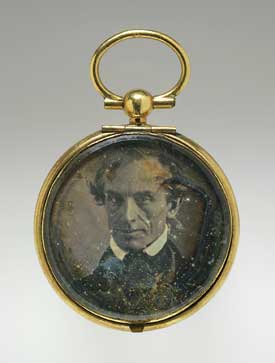Portrait of Samuel Morse

When a scarcity of commissions led Samuel Morse to reconsider his career as an artist, he turned from painting to pursue his earlier interest in inventing. In 1832, he conceived a plan for an electromagnetic recording telegraph and dedicated his energies to developing a working model for his invention.
When Morse applied for a patent in 1840, he had succeeded in devising a relay system for transmitting messages over long distances and had created the practical transmission code that bears his name.
For a time, lack of capital imperiled the future of his telegraph, but in 1843 Congress funded the construction of an experimental line between Washington, D.C., and Baltimore. One year later, Morse ushered in a new age in communications when he tapped out the first message, "What hath God wrought!"
This button-sized piece of daguerreian jewelry, featuring a portrait of Samuel Morse, was created around 1845 by artist Jonas M. Edwards. The piece is on display at the National Portrait Gallery, in the exhibition "Tokens of Affection and Regard: Photographic Jewelry and Its Makers" on the first floor. The exhibition, drawn primarily from the collection of Larry J. West, features rare and exquisite jewelry containing portraits in the 19th century's four main photographic processes—daguerreotypes, ambrotypes, tintypes and paper prints. Ann Shumard, curator of photographs at the National Portrait Gallery, recently discussed the piece at a Face-to-Face portrait talk.
Listen to Ann Shumard's Face-to-Face talk on Samuel Morse (31:06)
Face-to-Face occurs every Thursday evening at the National Portrait Gallery. The next Face-to-Face talk is this Thursday, April 16, when Professor Ben Click, of St. Mary's College of Maryland, speaks about Mark Twain. The talk runs from 6:00 to 6:30 p.m. Visitors meet the presenter in the museum’s F Street lobby and then walk to the appropriate gallery.
